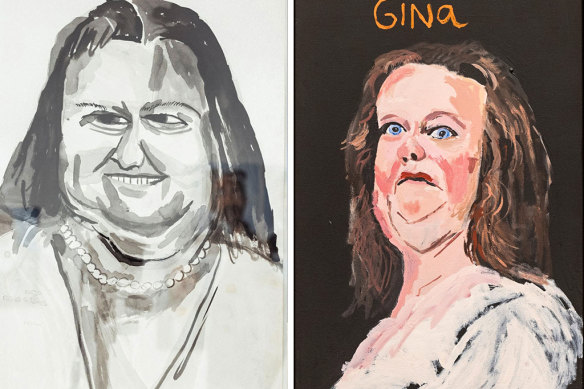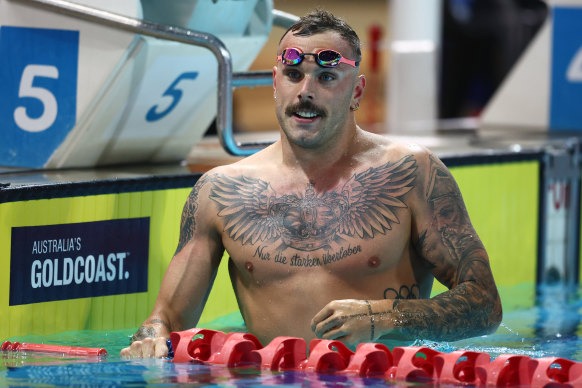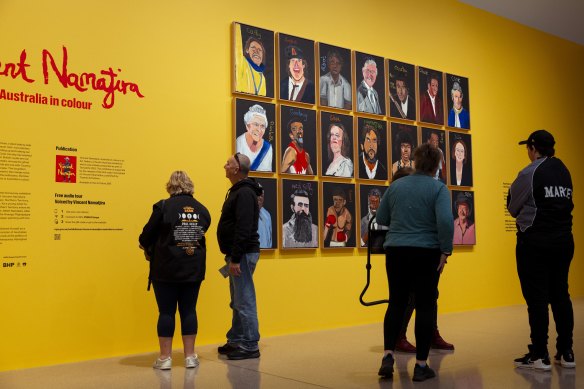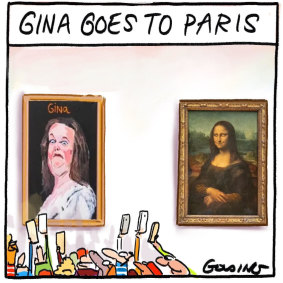- Exclusive
- Culture
- Art & design
- Art
Inside the campaign to take down Gina Rinehart’s portraits
By Linda Morris and Eryk Bagshaw
“One of Australia’s most prestigious people”, “our most powerful and successful woman”, “life-changing” and “humble”.
These are some of the testimonies used to describe Gina Rinehart in a month-long campaign against two National Gallery of Australia portraits of the mining magnate which would sweep up Seven chief executive and gallery chair Ryan Stokes, Opposition Leader Peter Dutton and Arts Minister Tony Burke.

Double or nothing: Vincent Namatjira’s portraits of Gina Rinehart were the subject of requests for removal.
Documents released under freedom-of-information laws reveal that Australia’s richest person used personal, political and business connections to demand a “disrespectful” and “extremely upsetting” portrait by award-winning Indigenous artist Vincent Namatjira be taken down.
The campaign began on April 8 when Stokes received a complaint from Rinehart about her depiction in two works by Namatjira.
Stokes passed on the complaint to National Gallery director Nick Mitzevich, who alerted Burke’s office that a lobbying blitz by Rinehart and her company Hancock Prospecting was under way.
“Subsequent to Mrs Rinehart’s complaint to the chairman, we have received two further complaints from people who appear to be employees (or former employees) of Hancock Prospecting,” Mitzevich wrote on April 10.
“I have also received a call from a former NCI [National Cultural Institutions] chair to advise Mrs Rinehart is rallying her friends to send complaints, demanding the works be removed from display.”
Those friends included Olympic swimmers, a female entrepreneur and a patron of the arts. The entrepreneur, whose name is redacted in the documents, said Rinehart was an “inspiring woman” whose “leadership had propelled her to great success”.
She accused the gallery of a “grossly unfair depiction of a prominent figure in Australian society” that only serves to “perpetuate stereotypes and undermine the achievements” of Rinehart.
Mitzevich was so concerned about the mounting complaints that he warned Burke’s office they could be raised in parliament by Dutton.
“I have responded to the complaints, however, felt I should elevate this to you in case these matters are raised by the leader of the opposition (who is close to Mrs Rinehart), so the minister can be prepared,” Mitzevich wrote.
Dutton did not raise Rinehart’s response in parliament, but he has had a long association with the mining magnate, whom he has called a “dear friend” and “great Australian”.
In November, Dutton took a private jet to sit next to Rinehart as her star guest at her party at Roy Hill mine in the Pilbara region of Western Australia. In March, he flew to Perth for Rinehart’s 70th birthday party. Then in June, Rinehart hosted two private political fundraisers for the opposition leader, The Australian Financial Review reported last week.
By May 2, more than 26 emails had been exchanged about the furore, according to the FOI documents.
At least three complainants wrote in near exact terms that they and thousands of others would not be where they were today if not for Rinehart’s generous contributions out of the “kindness of her heart”.

Australian swimmer Kyle Chalmers.Credit: Getty Images
Another complaint said the portraits “should be taken down and redone immediately”.
“Mrs Rinehart is one of the humblest, caring, down to earth people I have had the pleasure of spending time with,” wrote another.
One demanded the “insult” be met with a formal written apology from the NGA expressing regret for the “disrespectful portrayal”. Another described the works as “tawdry commercialism at best, cheap shots, resonating from a platform of ignorance”.
“In my opinion, this artwork should be removed and replaced with a portrait celebrating her and all she has done and continues to do for Australia,” one supporter said.
The contents of Rinehart’s original complaint have not been released, and all but one name of the complainants has been withheld, but they include elite Australian swimmers competing at the Olympics. Rinehart is expected to appear poolside in Paris this weekend.

The “Australia in Colour” exhibition including a Vincent Namatjira painting of Gina Rinehart.Credit: Dominic Lorrimer
Rinehart has paid more than $40 million in sponsorship to Australian swimmers through Swimming Queensland and her company’s Hancock Prospecting Swimmer Support Scheme.
Olympic gold medallist Kyle Chalmers and Kevin Hasemann, one of the top officials in Australian swimming, have previously confirmed their part in leading the charge against the Namatjira portraits.

Credit: Matt Golding
“Mrs Rinehart has proven herself to be a great Australian, and we respectfully urge you to reconsider the inclusion of these portraits in your galleries,” Hasemann wrote on May 2.
Namatjira’s exhibition, which closed last Saturday, also included satirical portraits of Queen Elizabeth, AFL star Adam Goodes and former prime minister Julia Gillard. The Indigenous artist and Archibald Prize winner is known for his rawness and sardonic treatment of subjects.
Mitzevich quoted Namatjira in his response to complainants informing them that the gallery would not be removing the paintings.
“Whether you’re a mining magnate, sportsperson, politician, musician, whatever – we are all equal here,” Namatjira wrote of the exhibition.
In the NGA’s defence, Mitzevich said the National Gallery’s remit was to be a reference point for art and art history.
“Since 1973, when the National Gallery acquired Jackson Pollock’s Blue poles, there has been a dynamic discussion on the artistic merits of works in the national collection, and/or on display at the gallery,” he said.
“We present works of art to the Australian public to inspire people to explore, experience and learn about art.”
Rinehart and Dutton were contacted for comment.
Start the day with a summary of the day’s most important and interesting stories, analysis and insights. Sign up for our Morning Edition newsletter.